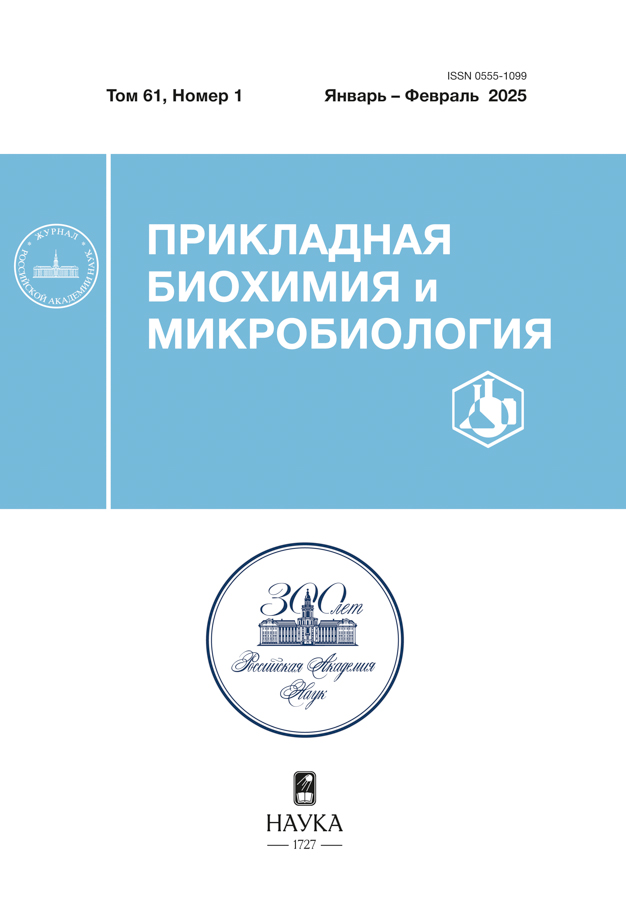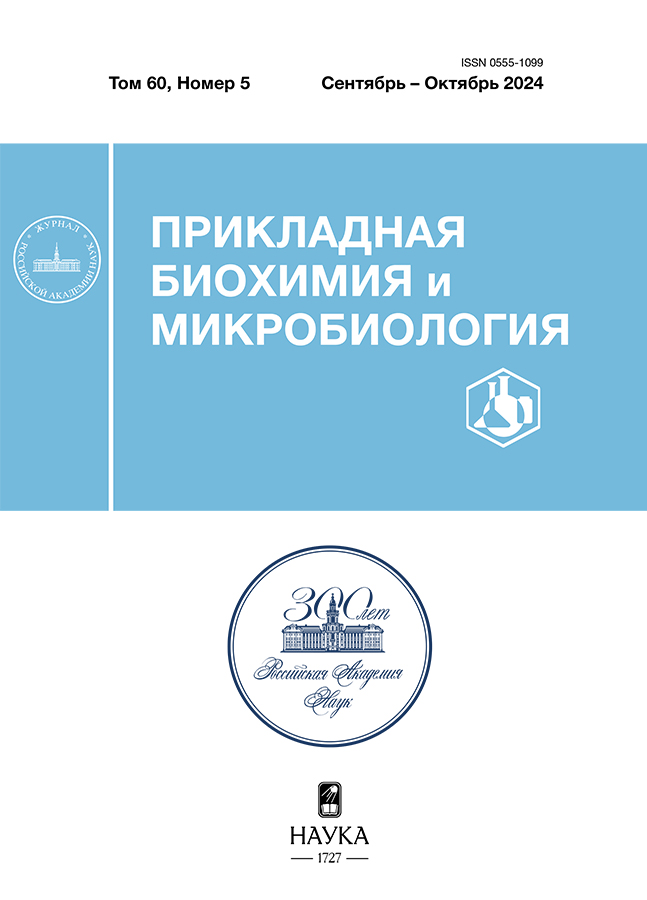Antioxidant effect of carnosine and carnosine dinitrosyl iron complexes at the conditions modeling peroxidation of biomolecules
- Authors: Nasybullina E.I.1, Kosmachevskaya O.V.1, Shumaev K.B.1, Topunov A.F.1
-
Affiliations:
- Research Center of Biotechnology of Russian Academy of Sciences
- Issue: Vol 60, No 5 (2024)
- Pages: 465-474
- Section: Articles
- URL: https://permmedjournal.ru/0555-1099/article/view/681854
- DOI: https://doi.org/10.31857/S0555109924050044
- EDN: https://elibrary.ru/QTVCXS
- ID: 681854
Cite item
Abstract
The antioxidant activity of carnosine and of carnosine dinitrosyl iron complexes (DNICs) was studied. A system with metmyoglobin (metMb) or gemin in combination with tert-butyl hydroperoxide (t-BOOH) was used as experimental model. Using luminol-dependent chemiluminescence method, it was shown that carnosine and carnosine DNICs effectively diminished the level of prooxidants formed by the interaction of heme groups with t-BOOH. In addition, carnosine and carnosine DNICs inhibited formation of diene conjugates arising during the oxidation of arachidonic acid in metMb―t-BOOH system. In used reaction systems, antioxidant effect of carnosine DNICs was higher than that of carnosine. Antioxidant effect of carnosine also depended on the presence of bivalent iron ions added at the concentration equivalent to their content in DNICs. These results show that the insertion of carnosine as a ligand to nitrosyl iron complexes enhances its antioxidant properties.
Full Text
About the authors
E. I. Nasybullina
Research Center of Biotechnology of Russian Academy of Sciences
Email: aftopunov@yandex.ru
Bach Institute of Biochemistry
Russian Federation, Moscow, 119071O. V. Kosmachevskaya
Research Center of Biotechnology of Russian Academy of Sciences
Email: aftopunov@yandex.ru
Bach Institute of Biochemistry
Russian Federation, Moscow, 119071K. B. Shumaev
Research Center of Biotechnology of Russian Academy of Sciences
Email: aftopunov@yandex.ru
Bach Institute of Biochemistry
Russian Federation, Moscow, 119071A. F. Topunov
Research Center of Biotechnology of Russian Academy of Sciences
Author for correspondence.
Email: aftopunov@yandex.ru
Bach Institute of Biochemistry
Russian Federation, Moscow, 119071References
- Boldyrev A.A., Aldini G., Derave W. // Physiol. Rev. 2013. V. 93. P. 1803–1845.
- Ihara H., Kakihana Y., Yamakage A., Kai K., Shibata T., Nishida M., Yamada K.I., Uchida K. // J. Biol. Chem. 2019. V. 294. P. 1279–1289.
- Caruso G., Pietro L.D., Cardaci V., Maugeri S., Caraci F. // Curr. Res. Pharmacol. Drug Discov. 2023. V. 4. e100153. https://doi.org/10.1016/j.crphar.2023.100153
- Abe H. // Biochemistry (Moscow). 2000. V. 65. № 7. P. 757–765.
- De Marchis S., Modena C., Peretto P., Migheli A., Margolis F.L., Fasolo A. // Biochemistry (Moscow). 2000. V. 65. № 7. P. 824–833.
- Berezhnoy D.S., Stvolinsky S.L., Lopachev A.V., Devyatov A.A., Lopacheva O.M., Kulikova O.I. et al. // Amino Acids. 2019. V. 51. № 1. P. 139–150.
- Ikeda T., Kimura K., Hama T., Tamaki N. // J. Biol. Chem. 1980. V. 87. P. 179–185.
- Abdelkader H., Longman M., Alany R.G., Pierscionek B. // Oxid. Med. Cell. Longev. 2016. V. 2016. e3240261. https://doi.org/10.1155/2016/3240261
- Malathy D., Anusha D., Karthika K., Punnagai K. // J. Clin. Diagn. Res. 2023. V. 17. № 7. P. FC01–FC05.
- Klebanov G.I., Teselkin Yu.O., Babenkova I.V., Lyubitsky O.B., Rebrova O.Yu., Boldyrev A.A., Vladimirov Yu.A. // Membr. Cell Biol. 1998. V. 12. № 1. P. 89–99.
- Decker E.A., Livisay S.A., Zhou S. // Biochemistry (Moscow). 2000. V. 65. № 7. P. 766–770.
- Banerjee S., Poddar M.K. // Archives of Gerontology and Geriatrics. 2020. V. 91. e104239. https://doi.org/10.1016/j.archger.2020.104239
- Babizhayev M.A., Yegorov Y.E. // Recent. Pat. Drug. Deliv. Formul. 2015. V. 9. № 1. P. 1–64.
- Menini S., Iacobini C., Fantauzzi C.B., Pugliese G. // Curr. Med. Chem. 2020. V. 27. № 11. P. 1744–1763.
- Solana-Manrique C., Sanz F.J., Martínez-Carrión G., Paricio N. // Antioxidants. 2022. V. 11. № 5. e848. https://doi.org/10.3390/antiox11050848
- Tabakman R., Lazarovici P., Kohen R. // J. Neurosci. Res. 2002. V. 68. P. 463–469.
- Kosmachevskaya O.V., Novikova N.N., Yakunin S.N., Topunov A.F. // Biochemistry (Moscow). 2024. V. 89. Suppl. 1. P. S180–S204.
- Berdaweel I.A., Monroe T.B., Alowaisi A.A., Mahoney J.C., Liang I.-C., Berns K.A., et al. // Front. Pharmacol. 2024. V. 14. e1275388. https://doi.org/10.3389/fphar.2023.1275388
- Maugeri S., Sibbitts J., Privitera A., Cardaci V., Di Pietro L., Leggio L. et al. // Cells. 2023. V. 12. № 22. e2592. https://doi.org/10.3390/cells12222592
- Bellia F., Amorini A.M., La Mendola D., Vecchio G., Tavazzi B., Giardina B., et al. // Eur. J. Med. Chem. 2008. V. 43. № 2. P. 373–380.
- Bellia F., Lanza V., Naletova I., Tomasello B., Ciaffaglione V., Greco V. et al. // Antioxidants. 2023. V. 12. № 8. e1632. https://doi.org/10.3390/antiox12081632
- Bertinaria M., Rolando B., Giorgis M., Montanaro G., Marini E., Collino M., Benetti E., Daniele P.G., Fruttero R., Gasco A. // Eur. J. Med. Chem. 2012. V. 54. P. 103–112.
- Shumaev K.B., Kosmachevskaya O.V., Nasybullina E.I., Gromov S.V., Novikov A.A., Topunov A.F. // J. Biol. Inorg. Chem. 2017. V. 22. № 1. P. 153–160.
- Shumaev K.B., Kosmachevskaya O.V., Nasybullina E.I., Ruuge E.K., Кalenikova E.I., Topunov A.F. // Int. J. Mol. Sci. 2023. V. 24. № 24. e17236. https://doi.org/10.3390/ijms242417236
- Shumaev K.B., Kosmachevskaya O.V., Timoshin A.A., Vanin A.F., Topunov A.F. // Methods Enzymol. 2008. V. 436. P. 445–461.
- Kagan V.E., Kozlov A.V., Tyurina Y.Y., Shvedova A.A., Yalowich J.C. // Antioxid. Redox Signal. 2001. V. 3. № 2. P. 189–202.
- Reeder B.J., Svistunenko D.A., Cooper C.E., Wilson M.T. // Antioxid. Redox Signal. 2004. V. 6. № 6. P. 954–966.
- Wilson M.T., Reeder B.J. // Molecular Aspects of Medicine. 2022. V. 84. e101045. https://doi.org/10.1016/j.mam.2021.101045
- Mihaljević B., Ražmem D. // Radiation Physics and Chemistry. 2003. V. 67. № 3–4. P. 269–274.
- Владимиров Ю.А., Проскурнина Е.В. // Успехи биологической химии. 2009. Т. 49. С. 341–388.
- Kang J.H., Kim K.S., Choi S.Y., Kwon H.Y., Won M.H., Kang T.C. // Mol. Cells. 2002. V. 13. № 3. P. 498–502.
- Shumaev K.B., Kosmachevskaya O.V., Grachev D.I., Timoshin A.A., Topunov A.F., Lankin V.Z., Ruuge E.K. // Biochemistry (Moscow), Supplement Series B: Biomedical Chemistry. 2021. V. 15. № 4. P. 313–319.
- Tamba M., Torreggiani A. // Int. J. Radiat. Biol. 1999. V. 75. P. 1177–1188.
- Nicoletti V.G., Santoro A.M., Grasso G., Vagliasindi L.I., Giuffrida M.L., Cuppari C., et al. // J. Neurosci. Res. 2007. V. 85. № 10. P. 2239–2245.
- Fontana M., Pinnen F., Lucente G., Pecci L. // Cell. Mol. Life Sci. 2002. V. 59. № 3. P. 546–551.
- Pattison D.I., Davies M.J. // Biochemistry. 2006. V. 45. № 26. P. 8152–8162.
- Kasamatsu S., Komae S., Matsukura K., Kakihana Y., Uchida K., Ihara H. // Antioxidants. 2021. V. 10. № 9. e1434. https://doi.org/10.3390/antiox10091434
- Mozdzan M., Szemraj J., Rysz J., Nowak D. // Basic Clin. Pharmacol Toxicol. 2005. Т. 96. № 5. P. 352–360.
- Peiretti G., Medana C., Visentin S., Giancotti V., Zunino V., Meineri G. // Food Chemistry. 2011. V. 126. № 4. P. 1939–1947.
- Gorbunov N.V., Tyurina Y.Y., Salama G., Day B.W., Claycamp H.G., Argyros G., Elsayed N.M., Kagan V.E. // Biochem. Biophys. Res. Commun. 1998. V. 244. № 3. P. 647–651.
- Hummel S.G., Fischer A.J., Martin S.M., Schafer F.Q., Buettner G.R. // Free Radic. Biol. Med. 2006. V. 40. № 3. P. 501–506.
- Kosmachevskaya O.V., Nasybullina E.I., Shumaev K.B., Novikova N.N., Topunov A.F. // Int. J. Mol. Sci. 2021. V. 22. № 24. e13649. https://doi.org/10.3390/ijms222413649
- Shoman M.E., Aly O.M. // Oxid. Med. Cell. Longev. 2016. V. 2016. e4018417. https://doi.org/10.1155/2016/4018417
- Kosmachevskaya O.V., Nasybullina E.I., Pugachenko I.S., Novikova N.N., Topunov A.F. // Antioxidants. 2022. V. 11. № 10. e2007. https://doi.org/10.3390/antiox11102007
- Tseng Y.-T., Chen C.-H., Lin J.-Y., Li B.-H., Lu Y.-H., Lin C.-H., et al.. // Chem. Eur. J. 2015. V. 21. P. 17570–17573.
- Lu S., Chiou T.-W., Li W.-L., Wang C.-C., Wang Y.-M. et al. // Inorg. Chem. 2020. V. 59. № 12 P. 8308–8319.
- Uchida K. // Amino Acids. 2003. V. 25. P. 249–257.
Supplementary files
















